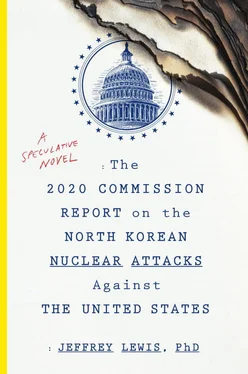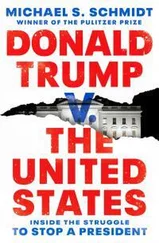Jeffrey Lewis - The 2020 Commission Report on the North Korean Nuclear Attacks Against the United States
Здесь есть возможность читать онлайн «Jeffrey Lewis - The 2020 Commission Report on the North Korean Nuclear Attacks Against the United States» весь текст электронной книги совершенно бесплатно (целиком полную версию без сокращений). В некоторых случаях можно слушать аудио, скачать через торрент в формате fb2 и присутствует краткое содержание. Город: New York, Год выпуска: 2018, ISBN: 2018, Издательство: Mariner Books, Жанр: Фантастика и фэнтези, Триллер, на английском языке. Описание произведения, (предисловие) а так же отзывы посетителей доступны на портале библиотеки ЛибКат.
- Название:The 2020 Commission Report on the North Korean Nuclear Attacks Against the United States
- Автор:
- Издательство:Mariner Books
- Жанр:
- Год:2018
- Город:New York
- ISBN:9-781-328-57391-9
- Рейтинг книги:4 / 5. Голосов: 1
-
Избранное:Добавить в избранное
- Отзывы:
-
Ваша оценка:
- 80
- 1
- 2
- 3
- 4
- 5
The 2020 Commission Report on the North Korean Nuclear Attacks Against the United States: краткое содержание, описание и аннотация
Предлагаем к чтению аннотацию, описание, краткое содержание или предисловие (зависит от того, что написал сам автор книги «The 2020 Commission Report on the North Korean Nuclear Attacks Against the United States»). Если вы не нашли необходимую информацию о книге — напишите в комментариях, мы постараемся отыскать её.
The 2020 Commission Report on the North Korean Nuclear Attacks Against the United States — читать онлайн бесплатно полную книгу (весь текст) целиком
Ниже представлен текст книги, разбитый по страницам. Система сохранения места последней прочитанной страницы, позволяет с удобством читать онлайн бесплатно книгу «The 2020 Commission Report on the North Korean Nuclear Attacks Against the United States», без необходимости каждый раз заново искать на чём Вы остановились. Поставьте закладку, и сможете в любой момент перейти на страницу, на которой закончили чтение.
Интервал:
Закладка:
In the Crisis Room, according to the memorandum of the meeting, General Jeong used that same word—“dead end.”
The military plan that General Jeong presented to President Moon during the emergency meeting on March 21 should not have come as a surprise. It had been developed a decade earlier, after a terrible year in which North Korea had engaged in a pair of high-profile provocations. In March 2010, a North Korean submarine used a torpedo to sink a South Korean naval corvette, the ROKS Cheonan, tearing the ship in half and sending forty-six South Korean sailors to a watery grave. (North Korea, of course, denied responsibility.) Then, in November, North Korea unleashed an artillery bombardment against Yeonpyeong Island, killing four South Koreans and injuring twenty-two more.
South Korea’s president at that time, Lee Myung Bak, had been enraged by the attack and ordered a retaliation against North Korea, but was frustrated by American officials who restrained him. Lee wanted a big and bold response, but military officials pushed him to consult with the United States, which retained wartime control over South Korea’s military forces. The Americans pressured Lee to scale back his plans for a retaliation. “South Korea’s original plans for retaliation were, we thought, disproportionately aggressive,” wrote Secretary of Defense Robert Gates. “We were worried the exchanges could escalate dangerously.” South Korea’s eventual response was anemic: satellite images later showed that its retaliation had done little or no damage to the North Koreans.
In the wake of this crisis, Lee pushed for South Korea to develop its own plans and capabilities to retaliate against North Korea in the event of a serious provocation such as a nuclear attack. These plans still required consultation with the United States, but Lee hoped that his successors would have more options to respond boldly to future aggressions by the North.
It was these capabilities that General Jeong presented to President Moon in the Crisis Room as a “three-axis” response to the downing of Flight 411. The military option featured a plan of attack, intelligence and strike capabilities to execute that plan, and missile defenses to limit the damage North Korea could do in retaliation.
The plan of attack presented by General Jeong was called “Korea Massive Punishment and Retaliation” and had been publicly described in some detail after 2016. It described an effort to “decapitate” North Korea’s government and military by using hundreds of long-range missiles and special forces to kill North Korea’s leadership, including Kim Jong Un. The plan named seventy-two distinct targets, including leadership targets in Pyongyang, military headquarters, and sites linked to North Korea’s nuclear and missile programs. The goal, according to one former Ministry of Defense official, was “wiping a certain section of Pyongyang completely off the map.” Pyongyang, a second official explained, would “be reduced to ashes.”
After presenting President Moon with the option of killing North Korea’s senior leaders, General Jeong explained that the plan would be carried out using what he called the “kill chain”: a series of military capabilities designed to detect and locate North Korea’s leaders and military forces linked to precision-strike capabilities to kill them. These capabilities included aircraft, long-range ballistic and cruise missiles, and a regimental-sized special forces team called SPARTAN 3000 that could be inserted into North Korea within twenty-four hours. General Jeong also offered a brief description of South Korea’s missile defense program, called Korea Air and Missile Defense (KAMD).
“Massive punishment, kill chains, KAMD—I don’t like things explained with military jargon,” Chief of Staff Im Jong-seok recalled. “But when General Jeong put it in plain words, I wasn’t sure it was an improvement.”
President Moon questioned General Jeong about the size of the strike and the number of targets. “President Moon was really surprised at how long the list of targets was,” Im recalled. “But General Jeong explained that the plan was based on an American operation against Saddam.” In 1998, the United States conducted Operation Desert Fox against Saddam Hussein’s Iraq, striking ninety-seven targets over four days, including three presidential palaces and the headquarters of the Iraqi Ba’ath Party. The two plans bore a striking similarity to each other.
According to survivors who had been present at the meeting, President Moon explained to General Jeong that he did not want to start a general war, but that he did want to find a small number of targets whose destruction would punish Kim Jong Un for the downing of BX 411. President Moon also suggested using only long-range missiles for this retaliatory attack. There was no reason, he said, to ask the special forces team to carry out a suicide mission or to put pilots at risk. Besides, it was important to hold something back to give Kim Jong Un something to think about. A small strike would shake Kim’s confidence, while the possibility of a larger strike to follow would box him in. “The general idea was to start with one or two targets,” Im explained. “Kim would know we were holding back the rest of the plan if he tried to escalate.”
President Moon looked over the list of targets. He asked about the first entry on the list of leadership targets, labeled L-01. It named the main Kim family compound on the outskirts of Pyongyang. Some of General Jeong’s military officers were uncomfortable with the idea of targeting Kim’s family home, but appeared reluctant to say so. “No one said, ‘I think this is too dangerous,’” Im explained, “but General Kim Yong-woo, the chief of the Army, and Admiral Um both said, ‘The Americans won’t like that.’”
General Kim suggested that, instead of hitting the Kim family compound, the missile strike should destroy the headquarters of North Korea’s Air Force, which was located in Chunghwa and commanded the air defense troops who shot down the aircraft. Chunghwa was a small military town about eleven miles south of Pyongyang. The Air Force headquarters there was a large compound with an office building and a pair of statues of Kim Il Sung and Kim Jong Un. These could be struck with little chance of civilian casualties. Admiral Um pointed out that North Korea’s Air Force bore responsibility for the mistake and that targeting it was a proportionate response.
“Moon got very angry,” Im explained. “He asked, ‘What’s a proportionate response for more than one hundred schoolchildren? I don’t think there is such a thing.’” Moon then turned the meeting back to Kim Jong Un’s residence. “I think Kim Jong Un must bear some responsibility too. He can’t always get away with things,” Moon finally said.
The South Korean president instructed General Jeong to hit both targets—to use a limited number of long-range missiles to strike both the Air Force headquarters and L-01, the Kim family compound outside Pyongyang.
Foreign Minister Kang made one last effort to take L-01 out of the strike package, raising the idea of consulting with the United States. But Moon turned the discussion aside by stating that this was his responsibility. Im recalled that Moon’s response to Kang’s suggestion that they contact Washington was ambiguous. “What he actually said was, ‘I’ll take responsibility.’ That might have meant that he would personally consult with the Americans, or it might have meant that he would be responsible for not consulting them.”
Moon then asked to speak directly to the commander of South Korea’s Army Missile Command. The subject, Im realized, was no longer up for discussion.
Prior to the events of March 2020, very few people were aware that South Korea maintained an elite military unit armed with long-range ballistic and cruise missiles. Once in a while, a South Korean leader might attend a missile test. But the military units assigned to launch these weapons in wartime were shrouded in secrecy. The South Korean press might allude to the fact that the Republic of Korea (ROK) Army had long-range missiles of its own, but the idea that there were about one hundred such missiles deployed to a half-dozen operational bases scattered across the country was almost never directly acknowledged.
Читать дальшеИнтервал:
Закладка:
Похожие книги на «The 2020 Commission Report on the North Korean Nuclear Attacks Against the United States»
Представляем Вашему вниманию похожие книги на «The 2020 Commission Report on the North Korean Nuclear Attacks Against the United States» списком для выбора. Мы отобрали схожую по названию и смыслу литературу в надежде предоставить читателям больше вариантов отыскать новые, интересные, ещё непрочитанные произведения.
Обсуждение, отзывы о книге «The 2020 Commission Report on the North Korean Nuclear Attacks Against the United States» и просто собственные мнения читателей. Оставьте ваши комментарии, напишите, что Вы думаете о произведении, его смысле или главных героях. Укажите что конкретно понравилось, а что нет, и почему Вы так считаете.












